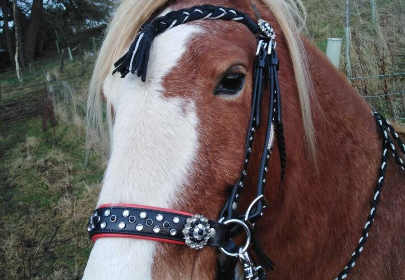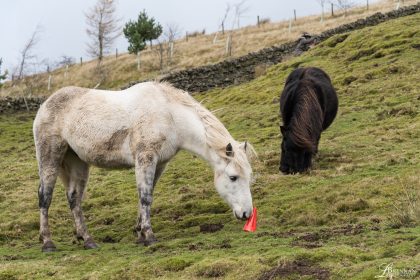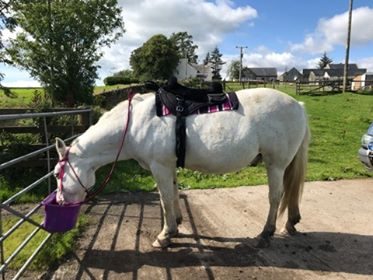Recently, I rather got into it with some people, as I put out a post on facebook commenting on the disconnect between the words used (something about love and connection) and the picture (horses with mouths strapped around bits, riders carrying whips.).
To me, that’s not what love looks like. Now, i don’t doubt for a second that millions of horse riders and owners use these items and genuinely love their horses, with no clue as to how the tools they are using make their horse feel.
I can’t say I’d feel very nicely towards my o/h if whenever he interacted with me he carried a taser ‘just incase’ I got out of line and needed to be controlled, even if he never used it and was nice in all other ways, the mere presence of the device would be enough to maker me feel anxious and modify my behaviour to ensure I kept him happy and made sure he didn’t use it.
TBF, he hardly ever carries it anymore 🙂 (JOKE!!!! he carries two.) (OK- jk again, he does not carry weaponry around me. That i know of…).
The vast majority of these people have never considered that the presence of the whip or the use of a bit might affect how their horse feels and behaves. What I mean by affecting how it behaves is that it might do things that it isn’t really emotionally/mentally/physically prepared for to avoid the owner employing these tools. The horse might not be happy leaving it’s friends at the yard, but it’s more worried about the whip, so picks the lesser of the two evils. It might have twinges which make it not want to do over that jump, but the alternative is a potential smack from the whip, so lesser evil again… you see how this works?
If the horse makes these choices quietly, then the owner probably has no clue that the horse is going through any sort of internal conflict. Why should they/ Their horse is just doing what they ask, no fuss, it must be happy!
This give a very blinkered view of how the horse feels about things as we are only seeing the coerced version. Some horses might come across things that they find more aversive than a smack or a yank on the bit, and at that point, the riders might start to realise that all is not as happy-clappy as they had previously thought…
The shit hit the fan when I said that in my opinion, if you aren’t willing to sit on your horse with no tack, if this is not a safe thing for you to do, then you have no business using tools to force your horse to behave in such a way that it is safe for you.
If your horse objects or says no or bolts, bucks, runs, bites, rears kicks or behaves in such a way that you can’t safely sit on him/her in a paddock or school, then as far as i’m concerned, you have to think ‘hmm, maybe we need to look at what he’s not happy about here’. Not just suppress his behaviour with tools.
I got blasted for this ‘You ride your horses with bridles!’ Yes, yes I do. AFTER I’ve taught them all the needed ridden cues with NO TACK AT ALL. Then we add the bridles and continue to use the same cues as we use with no bridles. It almost looks like we’re using the bridle for cues, but if you watch, you’ll notice stop is on a vocal cue, and i often ask for a turn with a hand signal without a rein in my hand. The bridle is there to 1) make us road legal and 2) to look pretty and 3) in the unlikely event of some kind of catastrophic disaster where i need to be able to pull my horse away from the rampaging T-Rex/out of the path of the molten lava etc.
I did my best to explain this, got some of the usual misconceptions ‘But sitting on a horse is pressure, so therefore you can’t do that coz it’s aversive’ . Ermmm, no, bless your heart, i’ll explain it quickly: A stimulus is either averisive (unpleasant) Neutral (kind of explains itself) or appetitive (a nice thing). The individual chooses if they find a stimulus aversive, neutral or appetitive. Now, if every time a human sits on a horse it is uncomfortable and means crappy stuff is going to happen, that would make it aversive. If nothing happened and the horses didn’t give two hoots about it, then it would be neutral. If in the case of my horses, there is a long history of reinforcement (food rewards and fun things) no discomfort, and the horse has freedom to choose if it wants to be sat on in the first place, then the act of having a human on their back can actually be appetitive. Pressure/touch doesn’t automatically equate to aversive unless the animal finds it aversive and their behaviour changes to AVOID that aversive touch, like using your legs/kicking your horse to make it move. If you squeeze your legs or nudge with your heels and you horse moves away from this, that means this kind of pressure is an aversive stimulus. Now, it is possible to teach leg cues without them being aversive, but that’s a whole other long blog post, so we won’t go into that now.
The other comments made were along the lines of ‘those horses look perfectly happy, they obviously don’t care about the bits and whips’. Ok, two points: 1) a bit is intrinsically aversive. That is a cold, hard fact. At best, the very least they do is prevent the horse from creating a mouth seal and affect breathing while being a bit bloody annoying; how is having some big thing strapped into your mouth anything but unpleasant? That was a literal punishment in the middle ages!
A scold’s bridle, sometimes called a witch’s bridle, a brank’s bridle, or simply branks, was an instrument of punishment, as a form of torture and public humiliation.[1] The device was an iron muzzle in an iron framework that enclosed the head (although some bridles were masks that depicted suffering). A bridle-bit (or curb-plate), about 2 in × 1 in (5.1 cm × 2.5 cm) in size, was slid into the mouth and either pressed down on top of the tongue as a compress or used to raise the tongue to lie flat on the wearer’s palate. This prevented speaking and resulted in many unpleasant side effects for the wearer, including excessive salivation and fatigue in the mouth
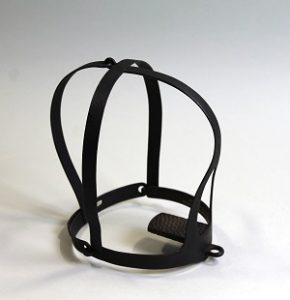
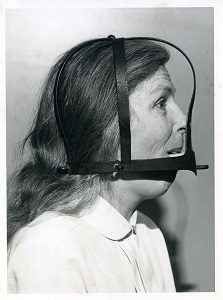

Apparently, enlightenment doesn’t extend to equines…
So we have established that bits just aren’t nice on any level, no matter ‘how light your hands are’, and at worst, can do awful damage to the mouth and tongue. We’ve all seen those pictures of tongues cut nearly in half, we’ve all seen horses with sores around the corners of their mouths, we’ve all seen blood around performance horses mouths… it’s just not right. In light of this, would you consider trying bitless? Your horse will absolutely thank you for it.
Oh, and for people who think their horses are happy about the bit, are they? Or are they happy about what it signifies? If you used treats to teach your horse to accept the bit, do you think he likes the bit or he likes the treats? If he could have the treats without the bit, would he? Or if your horses is stabled a lot, the bit might mean something much more stimulating and a chance to stretch his legs, again, a lesser evil.
As to why those horses ‘looked’ happy….. Long term exposure to an aversive stimulus lowers your reaction to it. The first dozen or so times I saw the taser in my partners hand, I was on high alert and I was very tense and anxious. After a while, it became normalised to me, I knew it was there, I kept on eye on it, but I acted pretty much like normal. If I got a bit too rowdy, his hand might brush against it and I remembered myself and behaved how he liked. (Again, NOT REAL. Just an analogy).
Which brings me to my final point. So we’ve established that tools can be used to make horses do things they don’t necessarily feel happy doing, and that by removing those tools, we can get a better idea of how they really feel about things. So when you see horses ridden in neck ropes and bitless bridles, it’s always all good, right? WRONG!
Sorry. I know I just made it even more complex, so bare with me, I have pictures!

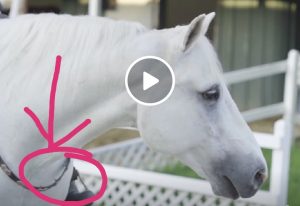
So picture 1, aww, nice, horse being ridden in a neck rope, nothing at all on his head! Picture 2. Look a little closer, WHAT THE ACTUAL FUCK?? THERE ARE SPIKES ON THE INSIDE OF THE NECK ROPE!!!! Fucked up, right? Not going to name names, but someone is taking credit for being an amazing trainer, a compassionate horseperson, ‘look, I don’t need bits or even bridles! (I just use spikes to control my horse!)’ Wonder how he’d behave if the neck rope was removed?
Unfortunately, there are also trainers who are so skilled with the use of aversive tools, they are able to create ‘Whips in the brain’. The avoidance behaviour becomes so deeply ingrained in the horse that even when the aversive tools are removed (to do a lovely demo or make a pretty video) the horse behaves as it would if they were still there. If the aversives were taken away for an extended period of time, the horse would likely experience what is known as Spontaneous Recovery, where they realise they are in a position to go actually, FUCK YOU! (This is what I experienced with Cato. I’d never ridden him with bits or whips, but his previous owners did and kept him beautifully shut down. After a while with me, he realised they were gone and…. BANG! (enter horsecharming to fix everything in a fully aversive-free manner). These trainers ‘remind’ the horse about the aversives every so often to keep them in their place.
To finish off, here is a nice picture of my pony Jango from yesterday. He has no bit, no whips, you can see evidence of a target, a treat pouch, a clicker which indicate the training methods used. He has on a buckyou bitless bridle with the reins lovely and loose and a buckyou bareback pad. We are on the road so his rider is wearing a high-viz also (we like to stay safe). He was trained using fully force free methods, there is no sign of conflict in his expression and no sign of any tools that could be used to create concern in him. And he is gorgeous. TTFN you bunch of dirty buckers!

PS- I can and do ride my po’s tackless on the fells, they stop and turn exactly as they do with tack! It’s an amazing thing to do, and I can help you do this with your horses too. Check out horse charming for one on one coaching in force free horsing.

